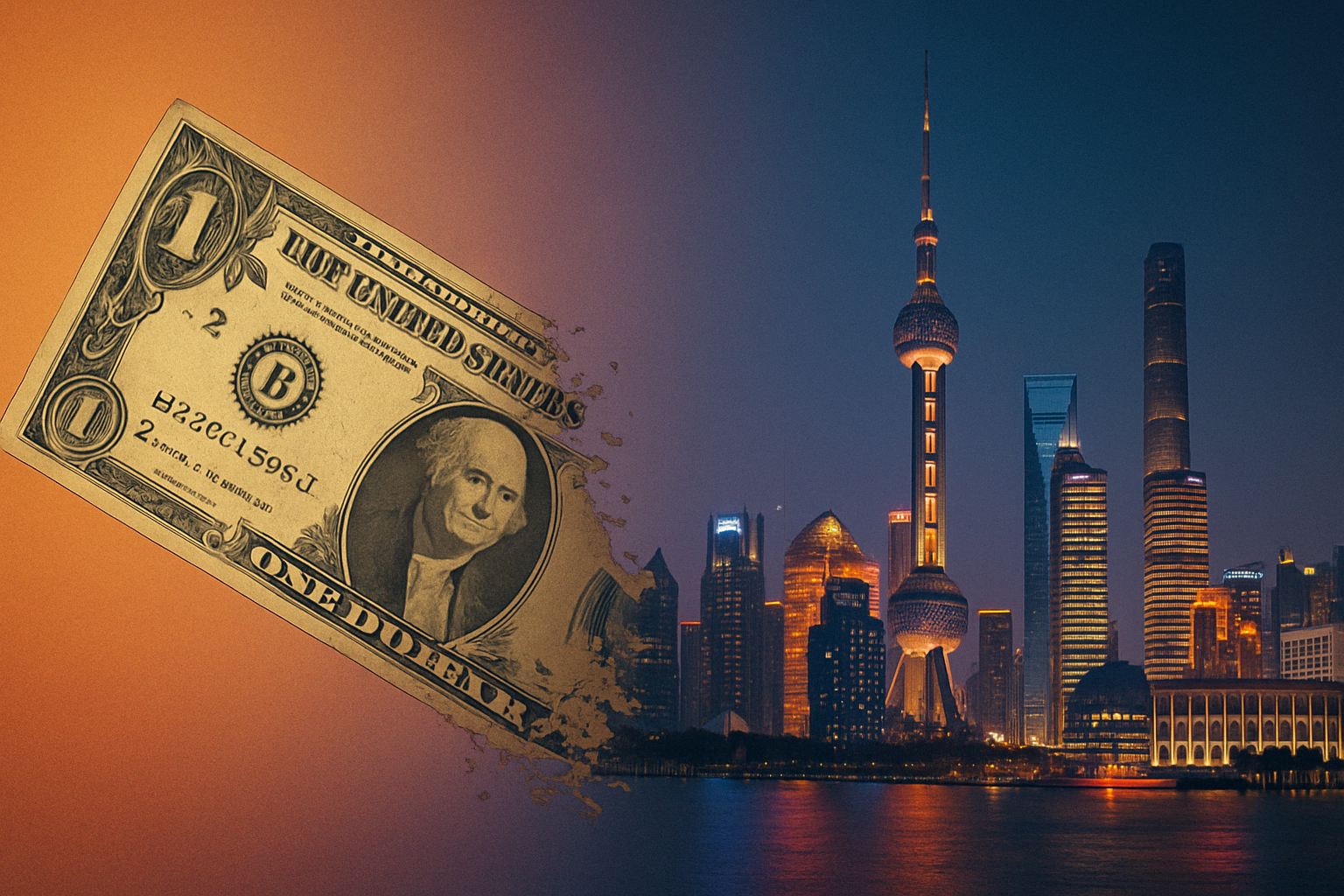The Plaza Accord and the Global Consequences of Dollar Weakness: Capital Flows, Emerging Market Booms, and Asset Bubbles
Background and Motivation
Let’s rewind to the early 1980s. The global economic order was at a turning point, and the U.S. found itself staring down a growing problem: a ballooning current account deficit and a dollar that just wouldn’t quit. Between 1980 and 1985, the greenback surged nearly 50%—not because of trade competitiveness, but thanks to sky-high interest rates under the Reagan administration.
For American manufacturers, it was a nightmare. Exports became uncompetitive, imports surged, and lawmakers in Washington were under increasing pressure from industries crying foul. Newsweek ran a cover story in 1984: “Made in America—But Can It Compete?” That headline summed up the mood. The answer? Not unless something changed—and fast.
Trade Politics Between the U.S. and Japan
If the dollar was the problem, Japan was the lightning rod. By the early 1980s, Japan had become an export juggernaut. Its industries were outpacing the West in everything from cars to consumer electronics. The result? A trade surplus with the U.S. that jumped from under $10 billion in 1980 to over $50 billion by 1985.
- Exploding Trade Deficit: U.S. automakers and steel producers couldn’t compete.
- Political Fallout: Congressman Richard Gephardt declared in 1985, “Japan’s economy isn’t free trade—it’s managed trade. And it’s hurting us.”
- Media Fury: The New York Times called Japan “The Trade Superpower That Plays by Different Rules.”
- Public Backlash: Lawmakers literally smashed Japanese electronics on Capitol Hill steps.
- Strategic Diplomacy: The U.S. turned to multilateral negotiation, bringing in France, West Germany, and the UK to pressure Japan.
This wasn’t just about economics. It was about power, prestige, and setting the rules of the post-Bretton Woods era.
Implementation of the Plaza Accord
On September 22, 1985, the G5 finance ministers gathered at the Plaza Hotel in New York and issued a rare joint communiqué. The goal? Engineer a decline in the dollar. “The dollar is overvalued, and we agree to act,” said then-Treasury Secretary James Baker. That wasn’t just talk. Central banks began actively intervening—selling dollars to push its value down and boost the yen and Deutsche Mark.
Why Japan Agreed: Politics and Pressure
Japan didn’t roll over easily. Behind closed doors, there was fierce debate in Tokyo. But a mix of diplomacy and geopolitics won out:
- Avoiding a Trade War: U.S. lawmakers were drafting protectionist bills. Japan blinked first.
- Security Calculus: Japan depended on the U.S. military umbrella. This was Cold War realpolitik.
- Political Optics: Finance Minister Noboru Takeshita wanted Japan seen as a responsible stakeholder in global finance.
- Technocratic Optimism: The Bank of Japan believed rate cuts and stimulus could offset the damage. They were half right.
Currency Realignment and the Surge in Purchasing Power
And so it began. The yen soared from 240 to the dollar to nearly 120 in just three years. That’s like doubling your money in international terms.
- Newfound Wealth: Japanese tourists swarmed Paris and New York. Department stores in London began accepting yen.
- Acquisition Spree: Sony bought Columbia Pictures. Mitsubishi took a stake in Rockefeller Center.
- “Japan Buys the World”: screamed the Los Angeles Times headline in 1989. And it felt true.
This wasn’t just a currency story—it was a national transformation. Japan went from exporter to global investor seemingly overnight.
Immediate Currency Effects
The DXY (Dollar Index) plunged from 164 in 1985 to under 90 by 1988. USD/JPY collapsed from ~240 to ~120. The dollar was falling, but global capital was just beginning to rise.
Japan’s Bubble: A Policy-Driven Frenzy
To soften the blow of the stronger yen, Japan turned on the stimulus taps:
- BOJ Cut Rates: From 5% to 2.5% within two years.
- Deregulation: Opened credit floodgates. The result? Leverage exploded.
- Nikkei Soars: Tripled from 13,000 to nearly 39,000 by end-1989.
- Real Estate Madness: Tokyo land was more valuable than all the real estate in California.
Banks lent recklessly. Corporates borrowed against inflated assets. Everyone assumed the boom would never end.
Global Expansion, Domestic Fragility
Flush with capital, Japan’s banks went global. They financed everything—from U.S. real estate to European soccer clubs. But the engine at home was overheating.
The Crash and the “Lost Decade”
In 1990, the BOJ finally slammed the brakes. Interest rates rose. And the bubble burst:
- Nikkei Collapse: Fell over 60%.
- Land Prices Tanked: Wealth vaporized.
- Stagnation Set In: Japan spent the next decade fighting deflation and zombie banks.
A cautionary tale—of capital gone wild, policy missteps, and the seductive power of easy money.
Broader Global Market Effects: Commodities, European Equities, and Emerging Markets
Now, let’s take a broader look. When the U.S. dollar began its steep decline post-Plaza Accord, the shockwaves weren’t confined to just the U.S. and Japan. The entire global financial ecosystem felt the tremors—and in some places, the ripple effects morphed into full-blown tsunamis.
Commodities: Agro and Industrial Metals Soar
When the dollar weakens, commodities priced in dollars usually surge. That’s exactly what happened. U.S. agricultural exports like soybeans, corn, and wheat became cheaper and more competitive. The world responded with demand. Simultaneously, industrial metals like copper and aluminum started rallying as Asia’s industrialization kicked into gear.
“Commodities Take Off as Dollar Softens” — Wall Street Journal, 1986
It wasn’t just a market move. It was a reshuffling of global pricing power, benefitting Latin American and Asian exporters massively.
European Currencies and Equities
The Deutsche Mark and French Franc surged. European exporters were squeezed, but consumers gained purchasing power. The seeds of European monetary cooperation were being sown.
- “Strong Mark Pressures German Auto Giants” — Frankfurter Allgemeine Zeitung, 1987
- Luxury goods from France and Italy boomed as Europeans flexed stronger currencies abroad.
Equities across Europe reacted unevenly: exporters struggled, but domestic-oriented sectors and diversified funds gained traction.
Emerging Market Capital Flows: The Rise—and Fall—of the Asian Tigers
You could feel it in the headlines. “Asia’s Boomtowns: Where Capital Chases Growth” — BusinessWeek, 1992. Global investors were pouring money into emerging Asia and Latin America, chasing the next big breakout.
Why? Because with U.S. rates falling and the dollar weakening, capital had to find a new home. And it found plenty in the likes of South Korea, Taiwan, Thailand, and even Brazil.
Asia – The Asian Tigers and Southeast Asia
- South Korea: Chaebols like Hyundai and Samsung grew at lightning speed. But much of it was debt-fueled. When the cycle turned, fragilities were laid bare.
- Taiwan: High-tech exports and cautious regulators kept things more stable. It remained a relative outlier during the crisis.
- Hong Kong: Rode a real estate and stock boom. Its USD peg added heat to the fire. Still, its financial architecture offered some buffers.
- Singapore: Attracted long-term capital, but with tight control. The city-state stayed a step ahead of overheating.
- Thailand: Open capital accounts and soaring current account deficits made it ground zero in 1997.
- Malaysia: Credit grew too fast. The property sector was overheated. A large devaluation followed.
- Indonesia: Crony capitalism plus short-term debt equals disaster. Its recession was among Asia’s deepest.
The Common Pattern
Boom, bubble, bust. Capital flowed in, fueled asset inflation, and left these economies vulnerable to shocks—especially with their debts denominated in dollars.
“We believed globalization was a safety net. Turns out, it was a fuse.” – Former Thai Finance Minister, 1999
Latin America – Risk and Reforms
- Mexico: Embraced liberalization but overvalued the peso. 1994’s Tequila Crisis erupted.
- Brazil: The Real Plan lured foreign capital but masked fiscal fragility. Crisis followed in 1999.
- Argentina: Dollar peg looked like stability—until it wasn’t. The 2001 collapse was brutal.
- Chile and Colombia: Played it safer with capital controls and exports. They weathered the storm better.
Timeline of Key Events
- 1985–87: Money pours into Asia and LatAm.
- 1989–91: Reforms accelerate. So does risk.
- 1994: Mexico implodes. Warning bells ring.
- 1997–98: Asia crashes. Russia defaults. LTCM nearly topples Wall Street.
- 1999–2002: Brazil and Argentina stumble. Growth turns into chaos.
So what’s the lesson here?
Capital flows are seductive. They drive growth. They build skylines. But if you’re not careful, they also build bonfires. And once the dollar turns, those flows reverse faster than most governments can react.
This era—between Plaza and Panic—was the blueprint for every emerging market boom and bust that followed.
“Capital is impatient. When the music stops, everyone reaches for the exit.” – Paul Volcker, former Fed Chair
Modern Parallels: The 2020s Dollar, China, and a New Plaza Moment?
Now let’s fast forward to 2025. If the story from the 1980s felt eerily familiar, it’s because we may be living through its sequel. Sure, the characters have changed—but the plot feels the same. Once again, the dollar is towering over its peers. Once again, the U.S. is frustrated with an export superpower. And once again, there’s talk of “rebalancing” global trade.
Here’s the thing: while the nominal U.S. Dollar Index (DXY) peaked just shy of 120—not quite the 160s we saw in 1985—the real effective exchange rate (REER) tells a different story. Adjusted for inflation and trade weights, the dollar today is just as strong, if not stronger, than it was at the height of the Plaza era.
What’s déjà vu, and what’s different?
- Overvalued Dollar: The REER makes it clear—this is not a narrow imbalance. The dollar’s strength today is broad-based, echoing the distortion we saw in 1985 when U.S. goods became globally uncompetitive.
- Widening Trade Deficits: Back then, it was Japan. Today, it’s China. And Vietnam. And Mexico. And Germany. America’s trade gap isn’t going away.
- Political Flashpoints: Remember Reagan’s frustration with Japan? Today, it’s Trump calling China a “currency cheater” and Biden pushing chip sanctions. Treasury Secretary Janet Yellen recently warned, “We won’t allow foreign mercantilism to shape the global economy.”
- Media Echoes: A recent Wall Street Journal headline read: “U.S. Struggles With ‘Weaponized Trade’: From Beijing to Berlin”. Swap a few names and you’re back in the 1980s.
- Strategic Tensions: Whether it’s 5G, AI, or semiconductors, the tech war has become a front in the broader Cold War 2.0. And like before, military posture in the Pacific is heating up.
So we ask: could there be another Plaza Accord? Maybe not a formal one. But soft coordination? Bilateral nudges? A Fed that’s quietly happy to see the dollar fall? It’s all possible. The economic logic is there, even if the diplomacy is messier.
What happened last time?
Here’s where history gets interesting—and cautionary:
- The Manufacturing Mirage: The weaker dollar in the late ’80s didn’t bring factories back to Ohio or Michigan. Automation, rising costs, and services-led growth left manufacturing behind. Sound familiar?
- Asset Bubbles Abroad: Japan. Korea. Thailand. Mexico. Cheap dollars went looking for yield—and found it in emerging markets. Until they didn’t. The carry trade created booms that ended in busts.
- A Shift in Supply Chains: As Japan got expensive, the baton passed to the Asian Tigers. Then to China. Globalization didn’t slow down—it accelerated. Ironically, dollar weakness made offshoring even more attractive.
- The Dollar’s Role Reimagined: No longer just a tool of trade policy, the dollar became the beating heart of global finance. It spawned carry trades, fueled shadow banking, and laid the foundation for the next two decades of global leverage.
- Lessons Ignored: We’ve been here before. And yet, the same arguments resurface: “Weaker dollar = more U.S. jobs.” But history tells a different story. Capital flows—not trade balances—are the main event. And when they reverse, the fallout is global.
The moral of the story? Be careful what you wish for. Because while a weaker dollar may sound good on paper, its real-world consequences ripple far and wide—and often in directions policymakers never intended.
So as we look ahead, we must ask not just what is happening, but where the capital might go next. And that, dear reader, may be the most important investment question of the decade.
A Probable Path: Dollar Depreciation as a Consequence of U.S.–China Trade Realignment
So where do we go from here? If you’ve been following the story, one thing becomes obvious: we’re likely heading toward a weaker dollar—not by decree, but by design.
This isn’t just guesswork. It’s what history whispers when the same patterns emerge. Just like the post-Plaza era, the conditions are lining up again. Except this time, the power dynamics are even more charged.
Here’s what’s pointing us in that direction:
- Twin Deficits Revisited
The U.S. is running both a fiscal and a current account deficit—and neither is getting smaller. Former Treasury Secretary Larry Summers once said, “There is no example in history of sustained current account deficits of this magnitude not ending badly.” Add to that aging demographics and rising entitlement costs, and you’ve got a recipe for structural dollar weakness.
- Policy Asymmetries
The Fed’s done the heavy lifting with rate hikes. But as inflation cools and recession fears simmer, they’re nearing the end of their rope. Meanwhile, the People’s Bank of China and others are still easing. That gap? It’s closing—and with it, support for the dollar.
- Deglobalization Pressures
“Buy American” is back. Reshoring is the new buzzword. But that also means higher costs and lower productivity. The Financial Times recently ran a headline: “Decoupling’s Real Cost: A Less Efficient World.” These shifts may sound patriotic, but they’re inflationary—and that’s poison for real yields.
- The Yuan’s Turning Point
China knows it can’t keep relying on exports. Western sanctions, rising wages, and bloated capacity are pushing Beijing to do what Tokyo did in the late ’80s—pivot inward.
- But unlike Japan, the yuan’s appreciation may not be imposed. It might be welcomed. Why? Because it unlocks purchasing power for China’s middle class.
- With households sitting on savings and relatively low debt, even modest currency gains could spark a wave of consumption. “Let the Chinese consumer lead the next global boom,” wrote Caixin Weekly.
- Portfolio Realignment
For decades, the dollar has been the default. But that’s changing—slowly, then suddenly. Central banks are diversifying. Investors are hunting for real yield in local-currency EM assets. A stronger yuan isn’t a footnote; it could be the next chapter.
- Strategic Isolation of China
Trump’s tariffs were only the beginning. Biden’s tech sanctions, export controls, and regional trade alliances like IPEF are all part of the same playbook: contain China.
In a 2023 address, Xi Jinping didn’t mince words: “We will not be bullied or isolated. China’s development is not up for negotiation.” That’s not just rhetoric—it’s a sign of resolve.
As the U.S. tries to freeze China out of global trade architecture, Beijing may be forced to lean harder into domestic demand. And that means making imports cheaper—possibly by letting the yuan rise.
All of this brings us to a turning point. The dollar’s strength isn’t eternal. And when the tide turns, capital will look for new homes.
Which leads us to the Hang Seng Index—a market many have written off, but few have truly understood.
Why the Hang Seng Index May Be Today’s Plaza Accord Parallel
If you’re still with me, here’s the punchline: history doesn’t repeat, but it does rhyme. And the Hang Seng Index might just be today’s version of Japan in 1986.
Back then, global capital chased the yen, riding a wave of revaluation and policy stimulus. The Nikkei exploded. Property boomed. Japan Inc. went global.
Could the same be brewing in Hong Kong?
- Today’s valuations are beaten down.
- The currency peg is stable.
- China’s policy pivot is real.
And if the yuan strengthens—even gradually—capital could come flooding in.
Overview of the Hang Seng Index: Structure and Valuation
The HSI is no longer just banks and utilities. It’s tech. It’s electric vehicles. It’s consumer finance. It’s China’s future—wrapped in a proxy investors can access.
Sector Breakdown (April 2025)
- Financials (~33%): HSBC, AIA, China Construction Bank
- Tech & Communication (~26%): Tencent, Alibaba, China Mobile
- Consumers (~14%): BYD, JD.com, Meituan
- Industrials & Others (~27%): HK & China Gas, CLP, property developers
Top 10 Constituents
|
These 10 companies make up over 53% of the index. It’s concentrated, yes—but also filled with leverage to policy shifts and consumer revival.
Valuation Snapshot (April 2025)
- P/E: ~11.95x
- P/B: ~0.91x
- Yield: ~4.2%
Compare that to the S&P 500’s 20x P/E and sub-2% yield, and you start to see the opportunity.
Key Risks to the Hang Seng Investment Thesis
Let’s not sugarcoat it. This is not a risk-free bet. Here’s what could go wrong:
- Trade War 2.0: Sanctions, tariffs, tech bans. A repeat of 2018 on steroids.
- Taiwan Flashpoint: The most dangerous geopolitical variable of our time.
- Capital Decoupling: U.S. asset managers could be forced to pull exposure.
- Policy Whiplash: Beijing has a track record of surprise regulation.
- Property Meltdown: Developers like Evergrande have already cracked the surface.
- Consumer Caution: Real estate is 70% of household wealth in China. Falling prices = falling confidence.
But here’s the thing: great trades rarely come gift-wrapped. They come when fear creates mispricing.
So the question isn’t whether there’s risk. It’s whether you’re being paid enough to take it.
And looking at the Hang Seng today, the answer might just be yes.




